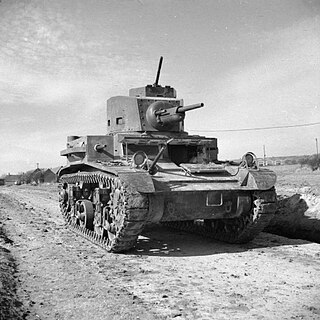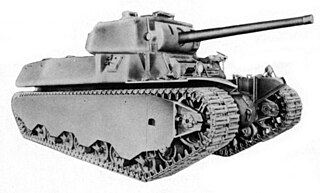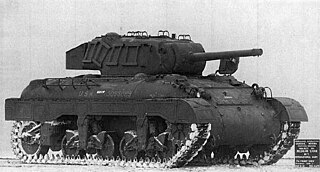Specifications
The Skeleton Tank weighed 9 tons and carried a boxy fighting compartment protected by a 1⁄2 inch (13 millimetres) of armor, which was in line with the armor thicknesses on other Allied tanks.
The crew of two consisted of the driver and the commander/gunner who manned the .30 (7.62 mm) caliber machine gun in the turret.
It was 25 feet (7.6 m) long, which compared favorably in trench-crossing potential to the then-standard heavy British Mk IV and Mk V tanks with lengths of 26 ft 5 in (8.05 m) but weights of 28 to 29 tons, and the French Schneider CA1 and Char d'Assault St. Chamond with lengths of 19 ft 9 in (6.02 m) and 28 ft 11 in (8.81 m) and weights of 13.5 and 23 tons respectively.
It was 8 ft 5 in (2.57 m) wide, narrower than the 10 ft (3.0 m) to 12 ft 5 in (3.78 m) of the British tanks, and slightly higher at 9 ft 6 in (2.90 m) vice 8 ft 8 in (2.64 m) for the Mk IV/V due to its turret.
It was never ordered into production.

A BT tank was one of a series of Soviet light tanks produced in large numbers between 1932 and 1941. They were lightly armoured, but reasonably well-armed for their time, and had the best mobility of all contemporary tanks. The BT tanks were known by the nickname Betka from the acronym, or by its diminutive Betushka. The successor of the BT tanks was the famous T-34 medium tank, introduced in 1940, which would replace all of the Soviet fast tanks, infantry tanks, and Light Tanks in service.

The M22 Locust, officially Light Tank (Airborne), M22, was an American-designed airborne light tank which was produced during World War II. The Locust began development in 1941 after the British War Office requested that the American government design a purpose-built airborne light tank which could be transported by glider into battle to support British airborne forces. The War Office had originally selected the Light Tank Mark VII Tetrarch light tank for use by the airborne forces, but it had not been designed with that exact purpose in mind so the War Office believed that a purpose-built tank would be required to replace it. The United States Army Ordnance Department was asked to produce this replacement, which in turn selected Marmon-Herrington to design and build a prototype airborne tank in May 1941. The prototype was designated the Light Tank T9 (Airborne), and was designed so that it could be transported underneath a Douglas C-54 Skymaster transport aircraft, although its dimensions also allowed it to fit inside a General Aircraft Hamilcar glider.

The M24 Chaffee was an American light tank used during the later part of World War II; it was also used in post–World War II conflicts including the Korean War, and by the French in the War in Algeria and the First Indochina War. In British service it was given the service name Chaffee after the United States Army General Adna R. Chaffee Jr., who helped develop the use of tanks in the United States armed forces. Although the M41 Walker Bulldog was developed as a replacement, M24s were not mostly removed from U.S. and NATO armies until the 1960s and remained in service with some Third World countries.

Panzerkampfwagen VIII Maus was a German World War II super-heavy tank completed in late 1944. It is the heaviest fully enclosed armored fighting vehicle ever built. Five were ordered, but only two hulls and one turret were completed, the turret being attached before the testing grounds were captured by advancing Soviet military forces.

The Renault FT was a French light tank that was among the most revolutionary and influential tank designs in history. The FT was the first production tank to have its armament within a fully rotating turret. The Renault FT's configuration became and remains the standard tank layout. Consequently, some armoured warfare historians have called the Renault FT the world's first modern tank.

The Tank, Infantry, Mk IV (A22) Churchill was a British infantry tank used in the Second World War, best known for its heavy armour, large longitudinal chassis with all-around tracks with multiple bogies, its ability to climb steep slopes, and its use as the basis of many specialist vehicles. It was one of the heaviest Allied tanks of the war.

The Tank, Infantry, Mk III, Valentine was an infantry tank produced in the United Kingdom during World War II. More than 8,000 of the type were produced in eleven marks, plus various specialised variants, accounting for approximately a quarter of wartime British tank production. The many variants included riveted and welded construction, petrol and diesel engines and a progressive increase in armament. It was supplied in large numbers to the USSR and built under licence in Canada. It was used extensively by the British in the North African campaign. Developed by Vickers, it proved to be both strong and reliable.

The Sturmpanzerwagen A7V was a heavy tank introduced by Germany in 1918 during World War I. One hundred chassis were ordered in early 1917, ten to be finished as fighting vehicles with armoured bodies, and the remainder as Überlandwagen cargo carriers. The number to be armoured was later increased to 20. They were used in action from March to October 1918, and were the only tanks produced by Germany in World War I to be used in combat, as well as being the first operational German Tank. It was developed as a response to British tanks. Although the A7V is generally considered to be better designed compared to its counterparts, it struggled to procure high production numbers due to its relative complexity and high cost.

The Medium Mark A Whippet was a British tank of the First World War. It was intended to complement the slower British heavy tanks by using its relative mobility and speed in exploiting any break in the enemy lines.

The TOG2, officially known as the Heavy Tank, TOG II, was a British super-heavy tank design produced during the early stages of World War II for a scenario where the battlefields of northern France devolved into a morass of mud, trenches, and craters as had happened during World War I. When this did not happen, the tank was deemed unnecessary, and the project terminated. A development of the TOG I design, only a single prototype was built before its termination.

The M2 light tank, officially Light Tank, M2, was an American light tank of the interwar period which saw limited service during World War II. The most common model, the M2A4, was equipped with one 37 mm (1.5 in) M5 gun and five .30 cal M1919 Browning machine guns.

Tanks were initially deployed in World War I, engineered to overcome the deadlock of trench warfare. Between the two world wars, tanks were further developed. Although they had demonstrated their battlefield effectiveness, only a few nations had the industrial resources to design and build them. During and after World War I, Britain and France pioneered tank technology, with their models generally serving as a blueprint for other countries. However, this initial advantage would slowly diminish during the 1930s, shifting in favor of the Soviet Union and, to a lesser degree, Nazi Germany.

The Heavy Tank M6 was an American heavy tank designed during World War II. The tank was produced in small numbers and never saw combat.

The M1 Combat Car, officially Light Tank, M1, was a light tank used by the U.S. Cavalry in the late 1930s and developed at the same time as the infantry's very similar M2 light tank. After the Spanish Civil War, most armies, realized that they needed tanks armed with cannons, not merely vehicles armed with machine guns, and so the M1 became obsolete.

The Special number 3 light tank Ku-Ro was an experimental Japanese winged light tank project, developed during World War II. It is one of the notable aircraft concepts developed during that war.

The Medium Tank M7, initially Light Tank T7, was an American tank, originally conceived as an up-gunned replacement for the Light Tank M3/M5 ("Stuart"). The project developed to mount the same 75mm armament as the M4 Sherman while retaining the light weight and maneuverability of the M3 Stuart; however, during development the weight of the prototype surpassed the US Army's standard for light tanks and crossed into the medium tank category and was renamed. The M7 had significantly less armor than the M4 Sherman, no greater firepower, and held only a slight advantage in top speed. For these reasons, and because the M4 was already battle-tested and in full production, the M7 was cancelled in 1943.

The T19 Howitzer Motor Carriage (HMC) was a 105 mm (4.1 in) howitzer mounted on a M3 Half-track chassis. It saw service during World War II with the U.S. Army. Its secondary armament consisted of an air-cooled .50 in (13 mm) M2 machine gun for local defense. It was produced by Diamond T between January 1942 and April 1942.

The M19 Multiple Gun Motor Carriage (MGMC) was a World War II United States Army self-propelled anti-aircraft weapon on the M24 light tank chassis. It was equipped with two Bofors 40 mm guns. It was produced by Cadillac and Massey Ferguson of Canada near the end of 1944.

The Type 87 Chi-I medium tank a/k/a Experimental tank No.1 was the first indigenously designed tank produced by Japan for the Imperial Japanese Army. Development of this medium tank began in June 1925 and was completed by February 1927. During the field trials, the tank proved to be too heavy and under-powered. The project was cancelled and a new light tank design was finished by April 1928 and designated the Type 89 I-Go.






















